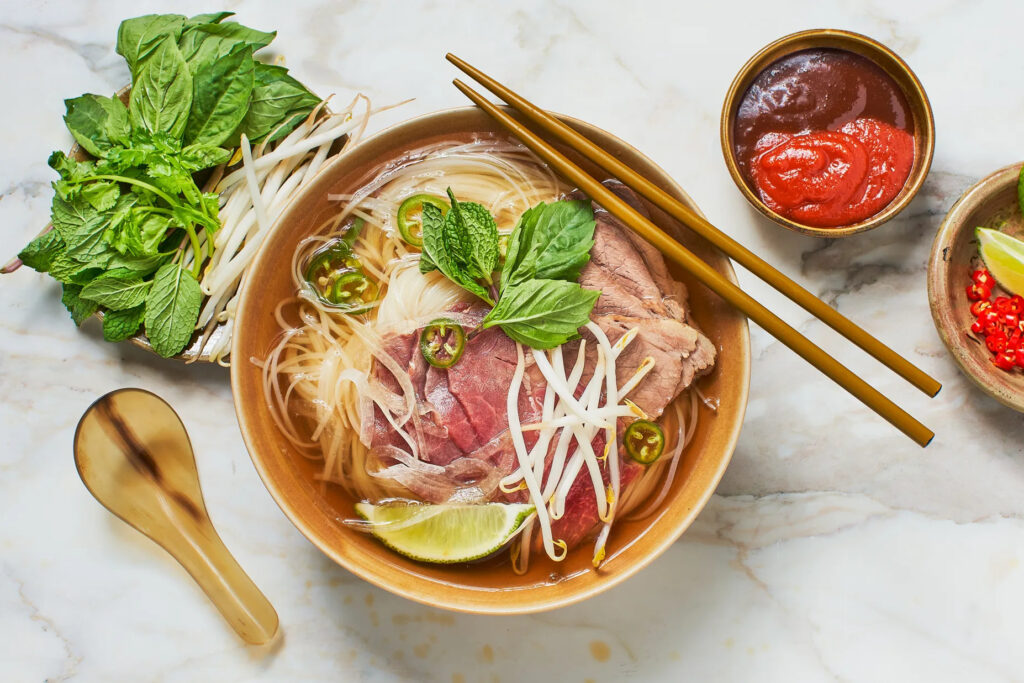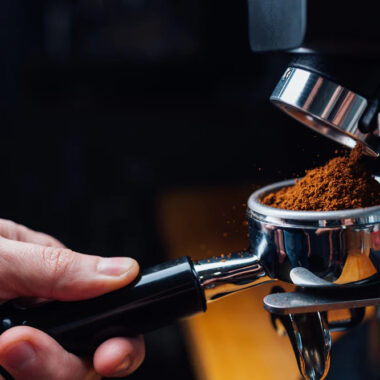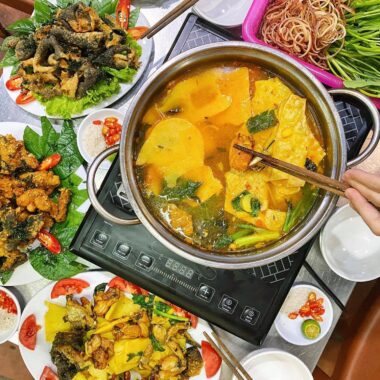Traditional Vietnamese food is always attractive and diverse with famous dishes from north to south. Delicious Vietnamese dishes are easy to make and easy to prepare even if you are a beginner at cooking. Let’s refer to Coolmate’s top list of delicious and famous traditional Vietnamese food recipes below with Tasty Touch!
- Pho (Phở)
- Thang Noodles (Bún Thang)
- Bun cha (Bún chả)
- Banh khot (Bánh khọt)
- Broken rice (Cơm tấm)
- Banh chung/banh tet (Bánh chưng/bánh tét)
- Fried spring rolls/spring rolls
- Cao Lau (Cao lầu)
- Summer rolls
- Banh beo (Bánh bèo)
- Quang noodles (Mì Quảng)
- Cha ca (Chả cá)
- Crab noodle soup (Bánh đa cua)
- Eel soup (Súp lươn)
- Mussel rice (Cơm hến)
- Mountain goat (Dê núi)
- Fish noodles (Bún cá)
- Braised fish (Cá kho tộ)
- Stewed chicken (Gà tần)
- Dried beef
Pho (Phở)

Pho was created in Hanoi and Nam Dinh in the early 20th century. Pho is a cuisine that is often prepared with pho noodles, served with broth, beef, or chicken, and seasonings like onions.
In any region of the nation, we may discover renowned noodle soup establishments, contemporary pho restaurant chains, or well-known pho establishments. As a result, pho is regarded as the “national soul” of Vietnamese cuisine and is among the most well-known and delectable of the country’s traditional fare.
Thang Noodles (Bún Thang)
As a refined and intricate Vietnamese cuisine tradition, bun thang is often exclusively served at Hanoians’ substantial celebrations. Bun Thang soup is made with chicken broth, hog bones, and water that has had the froth continually removed to maintain the water pure. The stock is then added to a string of dried shrimp. Omelet is likewise thinly sliced, as are fluffy white spring rolls.
Bun cha (Bún chả)
Bun cha is a classic Vietnamese dish that is popular in Hanoi and the rest of Northern Vietnam. Its popularity is comparable to that of pho. If pho is considered to be the meal that best exemplifies Vietnamese cuisine, then bun cha is the dish that receives the greatest praise from both culinary publications and professionals and is often regarded as the finest food that can be found in Vietnam.
Bun cha is a vermicelli meal that is often served with grilled pig buns (either minced or grilled meat), roasted on a charcoal grill to bring out the scent, and served with dipping sauce and fresh veggies. Bun cha is a traditional food from Vietnam. The fact that former President Obama and an American chef recently visited Hanoi to dine on bun cha contributed to the dish’s growing notoriety in the United States.
Banh khot (Bánh khọt)
If you have any interest in cuisine at all, you have undoubtedly come across the term “banh khot.” Rice flour is used as the primary ingredient in banh khot, and the preparation calls for a high level of expertise. When there is more cake flour than flour, the result will be dry and not chewy, but when there is more water than cake flour, the result will be pasty and not crispy. The red color of peeled shrimps and the green color of finely cut scallions show out against the white backdrop of the cake, and there is occasionally ground shrimp powder sprinkled on top of the cake as well.
Diners will find that the sweet and sour fish sauce used as a dipping sauce for banh khot is the perfect accompaniment to their meal. The cake is served with papaya, shredded carrots that have been soaked in sugar vinegar, as well as salad vegetables, basil, coriander, and perilla, all of which contribute to the dish’s overall depth of flavor.
Broken rice (Cơm tấm)
Broken rice is often consumed with the following four primary dishes: grilled pork ribs, pig skin, spring rolls, and omelets. The golden color of the grilled ribs, the milky white color of the soft, chewy skins, and the patty that is put firmly next to the round form of the newly made omelet are all shown on top of the steamed white rice in the front of the image.
This meal is served with tomatoes, cucumbers, carrots, or white radish that have been steeped in vinegar, and also, an essential cup of fish sauce that has been blended in accordance with the trade secret of each restaurant, which makes the dish taste even better. interesting.
Banh chung/banh tet (Bánh chưng/bánh tét)
The mythology of “banh chung and banh day” is associated with the traditional cuisine known as banh chung, which is more often referred to by its Southern counterpart, banh tet. Banh chung is said to have originated during the reign of the Hung King. The traditional methods of preparing banh chung, which include using unrefined materials, combining them with spices, braising over an open flame, and storing the dish for an extended period of time, are emblematic of Vietnamese folk culture. In the southern region of Banh Tet, there is a method that is similar, but rather than a square, it is a cylinder.
Fried spring rolls/spring rolls
Vietnamese people often prepare fried spring rolls for old celebrations or to honor the dead, particularly around Tet. Fried spring rolls have various variances in Vietnam, however, they are likely descended from Chinese food, particularly Hong Kong cuisine.
Traditional fried spring rolls consist of flour-based rice paper rolls that are wrapped around a filling of ground pork, vermicelli, mushrooms, and wood ear before being deep-fried. Fried spring rolls come in a wide variety of styles nowadays, including seafood spring rolls with seafood fillings (shrimp, crab, and fish) and a deep-fried breaded crust.
Cao Lau (Cao lầu)
A popular meal from Hoi An and Quang Nam, Cao Lau is named number four on CNN’s list of the top 40 Vietnamese foods. Cao Lau is a meal of mixed noodles with huge fibers, resembling udon noodles, with a stuffing of fresh veggies, grilled pork, and particularly crispy fried skin. The origins of Cao Lau are unclear, yet it is odd that this meal is attributed to the Chinese even though the Chinese do not recognize it as coming from them.
Summer rolls
The South is where summer rolls are most popular, while they are also enjoyed in the North, Central, and South areas. Since each area prepares them differently, there is practically no set recipe for summer rolls, but the basic components are rice paper and filling.
The greatest salad rolls include a whole shrimp inside in addition to the typical raw veggies, vermicelli, meat (beef, pig), eggs, and other ingredients. Summer rolls are often consumed as appetizers or while sipping beer, coated in soy and fish sauce. According to CNN, Goi Cuon is among the top 40 most delectable Vietnamese foods, and it is also placed seventh among the top 40 most well-known and tasty traditional Vietnamese cuisines.
Banh beo (Bánh bèo)
In addition to being highly well-liked in the South of Vietnam, banh beo is a very well-liked traditional Vietnamese dish in the Central area. Banh beo has evolved into a culinary masterpiece among the Vietnamese people for many years.
The dough is poured to create banh beo, which is then put in the labyrinth and steam-cooked until the cake is extremely thin and fashioned like a duck wing. Add spices to the cake after it has finished cooking. The shrimp lice and particularly the unique dipping sauce are responsible for the delicious banh beo. Fish sauce has a sweet and fatty flavor since it is made with fresh shrimp and a mixture of fat, sugar, garlic, and chile.
Quang noodles (Mì Quảng)
Quang noodles are not water noodles or fried noodles, but mixed noodles. Noodles are usually made from many different ingredients: shrimp, chicken, pork, snakehead fish, crab… There are vegetarian noodles for vegetarians as well. Depending on who likes to eat, there will be a bowl of noodles like that.
When eating noodles, it is indispensable for grilled rice paper, green chili, lemon slices, roasted peanuts, and a plate of raw vegetables (water spinach, banana buds, thinly sliced young banana stems, basil, lettuce, lettuce…).
Cha ca (Chả cá)
CNN’s list of the 40 most delectable dishes in Vietnamese cuisine places cha ca in second place, despite the fact that it is not nearly as well-known as the dishes that came before it. Cha Ca is not as common as it once was, although it used to be a popular snack on the streets of wealthy families living in major urban centers.
Cha ca is a delicacy prepared from fish that is similar to pork buns but uses fish instead of pork as the main ingredient. La Vong fish cake is widely considered to be the best fish cake dish. Hanoi, during the time period known as Indochina, is considered to be the city where the La Vong fish cake first appeared. Even now, the fish cake from La Vong continues to be one of Hanoi’s most well-known dishes.
Crab noodle soup (Bánh đa cua)
The people who live in and around the port of Hai Phong enjoy a food that is simple but comforting: crab noodle soup. A bowl of crab noodle soup that is both appetizing and visually appealing must have all five of the following colors: pink brown color of crab bricks, dark brown color of rice paper, the green color of spinach, water spinach, green onions, vivid red color in chile, and yellow color.
There are many places in Hai Phong where you can buy crab noodle soup; however, the most delicious shops only sell it during one time of day: either in the morning, the afternoon, or the evening. This may be done as a strategy to retain customers of the seller, but it can be difficult for customers who are traveling from afar because it can be difficult to find a good restaurant in Hai Phong if you aren’t familiar with the city.
Eel soup (Súp lươn)
After the eel flesh has been cleaned, it will be stir-fried with ground pepper, turmeric, and chili pepper. Eel bones, hog bones, beef bones, and fish bones are used to make the soup. Especially indispensable onion toothpick – onion only in Nghe An, Ha Tinh.
Bread or banh chung is often served with eel soup when it is served (like banh cuon but it is not rolled and has no filling). The coating on the cake is quite thin, and there is no filling. After that, break it up into pieces that are easily swallowed.
Mussel rice (Cơm hến)
Hue cuisine is known for its mussel rice. Cold rice is mixed with mussels that have been sauteed in oil and spices, mussel juice, fish sauce, mint, banana peel, Centella Asiatica, herbs, bean sprouts, fat or deep-fried balls, colored chili, whole peanuts, dill chili, pepper, monosodium glutamate, and salt to make the dish known as “mussel rice.”
Cold rice is mixed with mussels that have been sauteed in oil and spices, mussel juice, fish sauce, mint, banana peel, Centella Asiatica, herbs, bean sprouts, fat or deep-fried balls, colored chili, whole peanuts, dill chili, pepper, monosodium glutamate, and salt to make the dish known as “mussel rice.”
Let everything cool. Just the mussel water has to be heated. All of the aforementioned components are combined with a dish of mussel rice, and some mussel juice is then added on top. To flavor, mussel rice is often eaten with very hot chile.
Mountain goat (Dê núi)
The flesh of Ninh Binh mountain goats is harder, has a more herbal scent, and is richer than that of other varieties of farmed goats since they are wild animals that consume a range of natural vegetation. From goat cuisine, a variety of interesting meals are made, including goat blood soup, pan-fried goat, goat hot pot, goat curry, goat stewed with Chinese herbs, goat steamed with lemongrass and ginger, and goat stir-fried with rolls.
Additionally, a variety of goat parts are prepared into delectable meals, including the thighs, ribs, legs, feet, and pearls of the goat, which are often served with figs, cilantro, and basil.
Fish noodles (Bún cá)
The last dish in the list of delicious traditional Vietnamese food that we introduce today is fish noodles. Although it is a rustic dish, fish vermicelli is in the memory of many Vietnamese people. Every time we think of fish noodle soup, everyone wakes up in their minds with the passionate taste of their homeland.
Braised fish (Cá kho tộ)
Braised fish is a favorite dish of many Vietnamese housewives, an indispensable dish in family meals. The fish is boiled continuously in cooking oil, broth, garlic, onions, salt, fish sauce, and coconut milk until there is no fishy taste, the fish meat is soft and tender to the bone along with a little fatty meat creating a flavor. very attractive taste. The fish is stocked in a traditional earthenware pot, imbued with Vietnamese character, making it unforgettable for any foreign visitor once enjoying it.
Stewed chicken (Gà tần)
Stewed chicken is a kind of nutritious dish for Vietnamese people, helps to supplement waste, increase blood gas, reduce diabetes, reduce kidney failure, anti-aging, and anti-osteoporosis, and especially has positive effects on people with poor health. In ancient Vietnamese society, some chicken dishes were classified as royal dishes that were used to serve kings and high-ranking mandarins. Today, Stewed chicken is a nutritional food for every home.
Dried beef
Dried beef is a dish formed when ethnic minorities slaughter buffalo, if not eaten, the beef is spiced and then placed on the stove to dry. The way to make dried beef is also quite simple. Large pieces of meat are marinated with salt, and mixed with typical spices such as ginger, gac, and chili … After marinating, the pieces of meat are dried to shrink, then water-bathed, and continue to dry on the stove until completely dry.
Above is the top of the most delicious and famous traditional Vietnamese food. Have you tried them all yet? Which dish do you like the most? Please save it and enjoy it if you have the opportunity to visit Vietnam.





